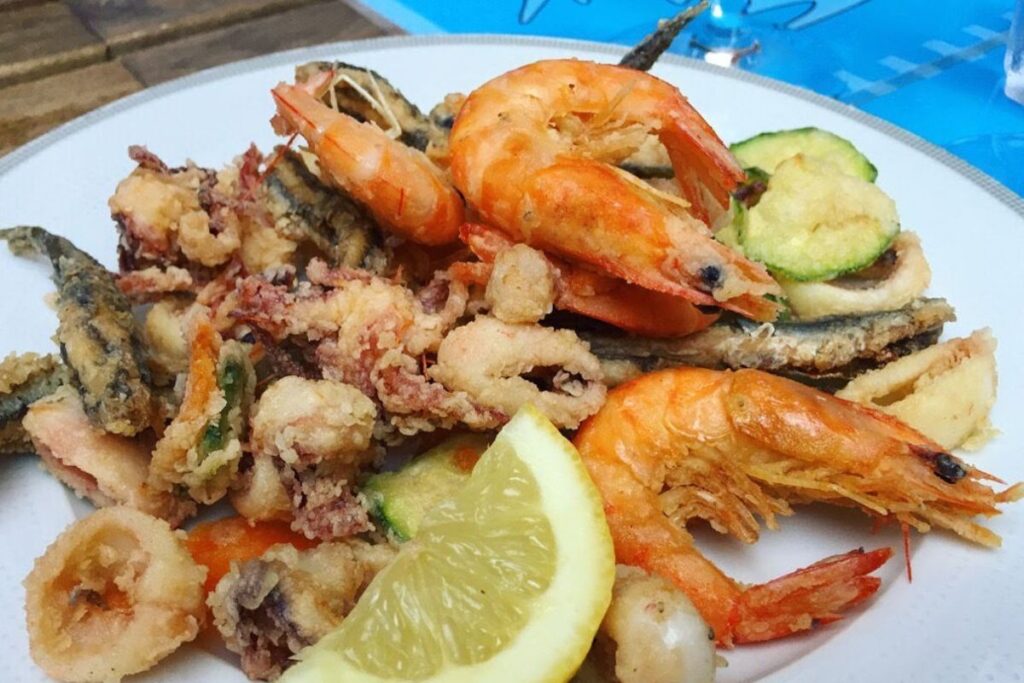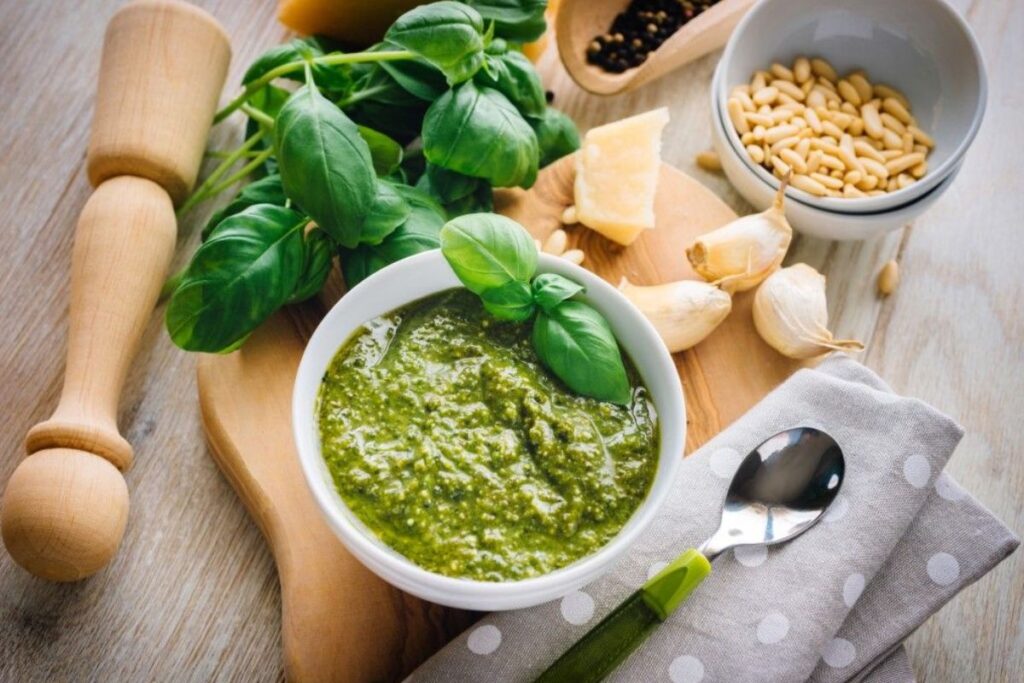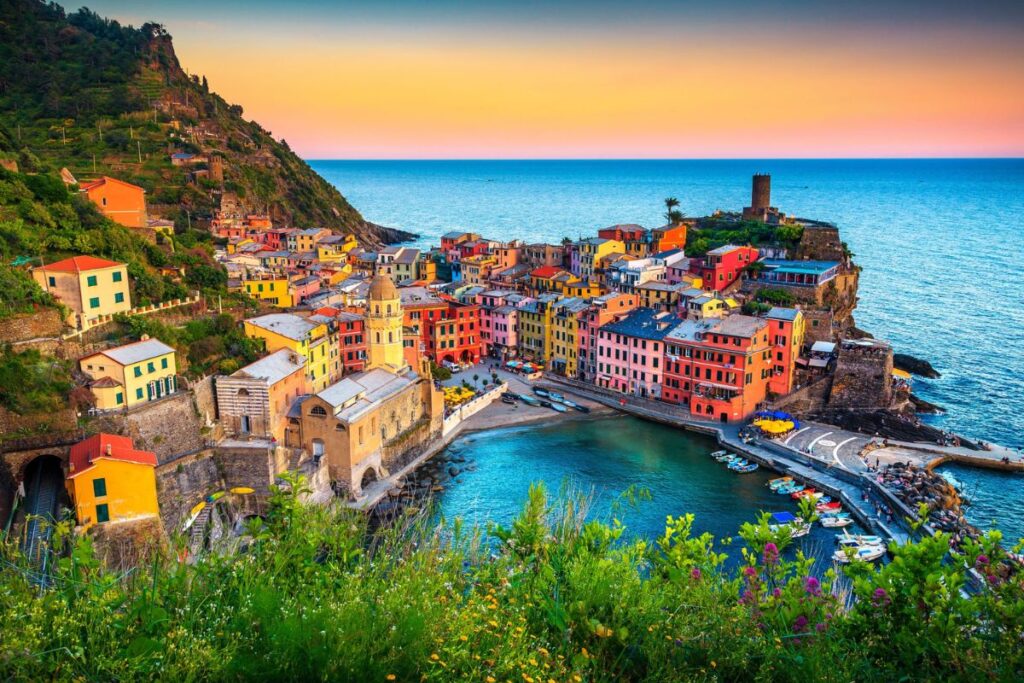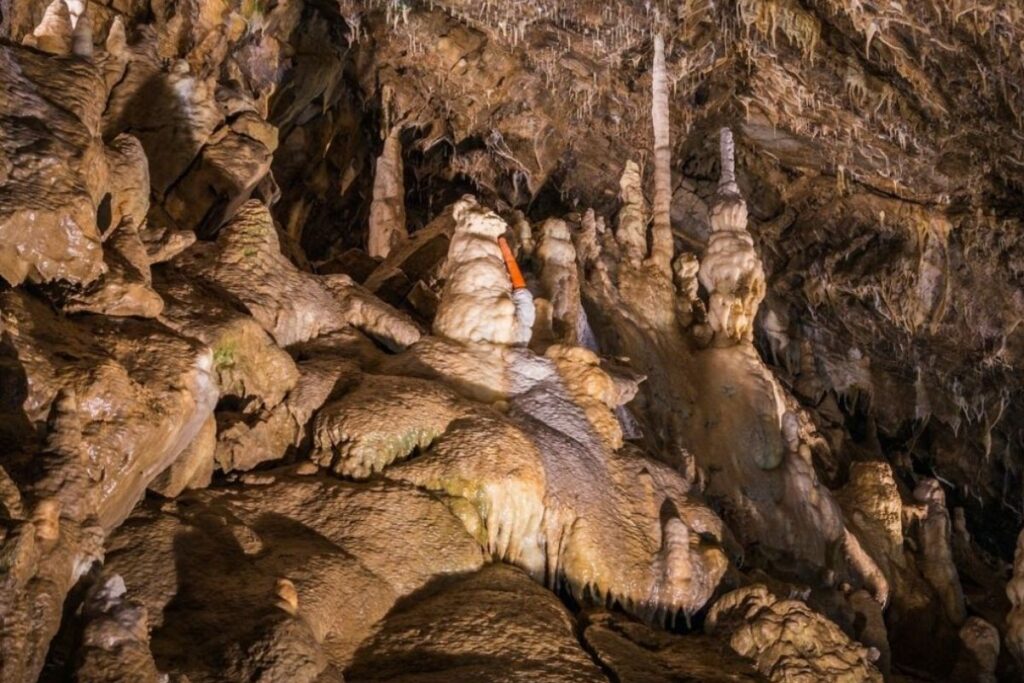Liguria, a crescent-shaped region in northwest Italy, offers an enchanting mix of stunning coastal scenery, historic towns, and mouth-watering cuisine. Stretching from the French border down to Tuscany, it’s a narrow strip of land bordered by the Ligurian Sea and the rugged Apennine Mountains. Here’s a deep dive into everything that makes Liguria a must-visit destination.
Location and Climate

Liguria, a stunning coastal region in northwest Italy, is celebrated for its Mediterranean climate and enchanting location along the Italian Riviera. Thanks to its proximity to the Mediterranean Sea, Liguria enjoys warm, sunny summers with average temperatures ranging from 25°C to 30°C (77°F to 86°F), and mild winters where temperatures rarely dip below 5°C (41°F) on the coast. The mild climate, tempered by sea breezes, makes Liguria an ideal year-round destination. Rainfall is moderate but often concentrated in the autumn, when powerful storms can roll in from the sea, creating dramatic weather along the coast and lush greenery in the valleys.
Nestled between the Ligurian Sea and the Apennine Mountains, Liguria’s landscape is a blend of rugged cliffs, sandy beaches, and vibrant towns like Genoa, Portofino, and the Cinque Terre. This narrow stretch of land is uniquely shaped by its proximity to the sea on one side and the sheltering mountains on the other, creating a range of microclimates. The Riviera di Ponente (to the west) and Riviera di Levante (to the east) both offer picturesque coastlines, but with subtly different atmospheres and terrain. Inland, the mountainous regions are cooler and home to forests, vineyards, and charming hillside villages, making Liguria not only a paradise for beach lovers but also for hikers and nature enthusiasts seeking diverse Italian landscapes.
Historical Overview

Liguria’s history is as rich and varied as its landscapes, tracing back to ancient times when the Ligurian tribes first settled this rugged coastal region. Positioned along key Mediterranean trade routes, Liguria attracted numerous cultures over the centuries, including the Phoenicians, Etruscans, and Greeks, each leaving an indelible mark. However, it was under Roman rule that Liguria began to flourish as an important trading hub, connecting the empire’s vast network through the port city of Genoa. By the medieval period, Genoa emerged as a powerful maritime republic, rivaling Venice and Pisa, and building a formidable fleet that would dominate Mediterranean trade and exploration for centuries.
Throughout the Renaissance, Liguria continued to prosper as Genoa reached its peak as a banking and cultural center, giving rise to magnificent palaces, churches, and artworks that still grace the region today. The Republic of Genoa maintained its independence for nearly 800 years until it fell to Napoleonic forces in 1797. After the Congress of Vienna in 1815, Liguria became part of the Kingdom of Sardinia, eventually joining the unified Kingdom of Italy in 1861. Today, Liguria’s historical legacy is celebrated through its well-preserved architecture, ancient coastal villages, and vibrant cultural traditions, drawing visitors eager to explore the remnants of its storied past alongside its beautiful coastlines and landscapes.
Major Cities

Genoa
The capital city, Genoa, is a bustling port city with a rich maritime heritage. Its historical center, one of the largest in Europe, is a labyrinth of narrow alleys, medieval buildings, and hidden gems. The UNESCO-listed Palazzi dei Rolli and the impressive Genoa Cathedral are must-sees.
La Spezia
Serving as the gateway to the Cinque Terre, La Spezia is known for its naval base and picturesque waterfront. The city is also home to several museums, including the Naval Technical Museum, which offers insights into Italy’s maritime history.
Savona
A lesser-known gem, Savona boasts a charming old town, beautiful beaches, and the imposing Priamar Fortress, which offers stunning views over the city and sea.
Sanremo
Famous for its annual music festival, Sanremo also offers elegant architecture, lush gardens, and a historic casino, making it a vibrant cultural destination.
Foods and Cuisine

Liguria, the breathtaking coastal region of northwest Italy, is known for more than its stunning seaside views and charming villages. It’s a haven for food lovers who come to savor its fresh, flavorful cuisine, rooted in centuries-old traditions and ingredients unique to this Mediterranean landscape. Ligurian food is simple yet exquisite, with flavors that showcase the bounty of the sea, the richness of olive oil, and the aroma of locally grown herbs. From iconic pesto and seafood specialties to rustic breads and hearty pastas, Ligurian cuisine reflects the region’s deep connection to its land and sea. Here, we’ll explore some of the must-try dishes and culinary highlights of Liguria.
Pesto alla Genovese: Liguria’s Signature Sauce
One of Liguria’s most famous contributions to Italian cuisine is pesto alla genovese, the vibrant green basil sauce that originated in Genoa. Pesto is made with just a few simple ingredients: fresh basil leaves, garlic, pine nuts, grated Parmesan and Pecorino cheese, and Ligurian extra-virgin olive oil. Traditionally, pesto is pounded by hand in a marble mortar with a wooden pestle, which helps preserve the basil’s aroma and color. This beloved sauce is most commonly served with trofie pasta, a small twisted pasta that clings to the pesto perfectly, or with gnocchi, creating a dish that is light yet bursting with flavor. Pesto alla genovese captures the essence of Ligurian cuisine: fresh, aromatic, and full of local character.
Focaccia: The Staple Bread of Liguria
Liguria is also known as the birthplace of focaccia, a flat, oven-baked bread that is soft on the inside with a golden, crispy crust. Focaccia in Liguria comes in many variations, from the simple focaccia genovese, topped with just olive oil and sea salt, to focaccia di Recco, a thin, cheese-filled version that is unique to the town of Recco. Locals often enjoy focaccia as a snack or breakfast treat, sometimes paired with coffee or dipped in olive oil. Another variation is focaccia alle olive, which includes whole olives pressed into the dough, adding a briny, savory kick. Focaccia’s versatility and satisfying flavor make it a quintessential part of Ligurian daily life.
Farinata: The Savory Chickpea Pancake
Farinata is a beloved Ligurian street food that showcases the region’s ingenuity with simple ingredients. This savory pancake is made from chickpea flour, water, olive oil, and a pinch of salt. The batter is poured into a wide, shallow pan and baked in a high-temperature oven until golden and crispy on the outside, with a soft, creamy interior. Farinata is often served in slices and eaten hot, sometimes with a sprinkle of black pepper or rosemary for extra flavor. It’s a comforting, gluten-free snack that you’ll find in bakeries and street vendors throughout Liguria, and it pairs wonderfully with a glass of local wine.
Ligurian Seafood: Fresh from the Mediterranean
Being a coastal region, Liguria has a seafood-rich cuisine that celebrates the daily catch from the Mediterranean. Anchovies, a Ligurian specialty, are often enjoyed marinated in lemon juice, grilled, or even fried for a quick, flavorful bite. The traditional dish acciughe ripiene (stuffed anchovies) is a must-try, with anchovies filled with breadcrumbs, garlic, and parsley, then baked or fried. Octopus, calamari, and mussels are also popular and are featured in various dishes, from pasta sauces to zuppa di pesce (fish soup), a hearty and fragrant seafood stew. The flavors are kept simple to let the freshness of the seafood shine, and dishes are typically finished with a drizzle of olive oil and a sprinkle of local herbs.
Trenette al Pesto and Other Pasta Dishes
Liguria has its own set of pasta traditions, with each variety perfectly suited to the region’s sauces and ingredients. Trenette al pesto is one of the most iconic Ligurian pasta dishes, combining trenette (a thin, flat pasta similar to linguine) with pesto sauce, potatoes, and green beans. The addition of potatoes and green beans makes the dish hearty and deliciously satisfying. Another Ligurian specialty is pansotti, a triangular-shaped pasta filled with ricotta and wild herbs, served with a walnut sauce called salsa di noci. This dish is creamy and nutty, with a rich flavor that highlights Liguria’s love for simple yet robust sauces.
Ligurian Desserts: Sweet Treats by the Sea
Ligurian desserts are often understated but full of flavor, focusing on fresh ingredients and traditional techniques. Canestrelli are crumbly, flower-shaped cookies dusted with powdered sugar that are often enjoyed with coffee or wine. These buttery treats have a melt-in-your-mouth texture that makes them a favorite for locals and visitors alike. Another popular dessert is pandolce, a sweet bread similar to fruitcake, filled with raisins, pine nuts, and candied citrus. Originating in Genoa, pandolce is traditionally served during Christmas, but you can often find it year-round. Liguria is also known for its sciacchetrà, a rare dessert wine from Cinque Terre made from sun-dried grapes, which pairs wonderfully with desserts and cheese.
Ligurian Wine: The Perfect Pairing
Liguria’s wines are a hidden gem, often overshadowed by the wines of neighboring Tuscany and Piedmont. However, the region produces several exceptional varieties, thanks to its steep, terraced vineyards that overlook the sea. Vermentino and Pigato are two popular white wines that are crisp and aromatic, making them an ideal match for seafood and pesto dishes. For a unique treat, try sciacchetrà, a rare, golden-hued dessert wine from Cinque Terre. Made from partially dried grapes, sciacchetrà has a complex, honeyed flavor and is often enjoyed with desserts or aged cheeses. Ligurian wines are a true reflection of the region’s landscape, crafted with care by small-scale, family-owned vineyards.
Experience Liguria Through Its Food
Liguria’s cuisine is a journey through the region’s culture, history, and natural beauty. From the world-famous pesto alla genovese and simple, satisfying focaccia to the region’s abundant seafood and flavorful wines, Ligurian food is all about celebrating fresh ingredients and timeless recipes. Each dish tells the story of Liguria’s coastal life and its deep connection to tradition, offering a taste of the Mediterranean that is both authentic and unforgettable. So, whether you’re planning a trip to Liguria or just dreaming of Italy, savoring Ligurian flavors is a delicious way to experience the essence of this enchanting region.
Agriculture and Crops

Liguria, Italy’s enchanting coastal region, is as famous for its dramatic seaside cliffs and charming villages as it is for its thriving agricultural traditions. Though Liguria’s mountainous terrain and narrow strips of land may seem challenging for farming, the region has ingeniously adapted with terraced landscapes that hug the hillsides, allowing for rich, diverse agriculture. With its Mediterranean climate, ample sunshine, and gentle sea breezes, Liguria produces a range of prized crops that are celebrated not only across Italy but around the world. Here, we’ll explore some of the key agricultural treasures of Liguria and the unique ways they contribute to the local economy and culture.
Olive Oil: The Gold of Liguria
Liguria is renowned for its high-quality olive oil, often referred to as “liquid gold.” The region’s olive oil production is centered around the Taggiasca olive, an indigenous variety grown primarily in the western provinces of Imperia and Savona. These small, dark olives are packed with a rich, fruity flavor that makes Ligurian olive oil a staple in Italian kitchens and beyond. Taggiasca olives are meticulously hand-picked and cold-pressed, yielding a smooth, delicate oil with a hint of sweetness and low acidity. This makes it perfect for drizzling over salads, pastas, and fresh fish. Ligurian olive oil is also highly regarded for its health benefits, packed with antioxidants and healthy fats that make it a staple in the Mediterranean diet.
Basil and Pesto: Liguria’s Green Gold
No discussion of Ligurian agriculture would be complete without mentioning basil, the star ingredient in the world-famous pesto alla genovese. Liguria’s unique climate and coastal microclimates are ideal for cultivating basil with a soft, tender leaf and intense aroma. Basil from Liguria has earned a Protected Designation of Origin (PDO) status, guaranteeing its quality and authenticity. The region’s pesto sauce is traditionally made with fresh basil leaves, pine nuts, garlic, Parmesan, and Pecorino cheese, all blended with Ligurian olive oil. Pesto is a versatile sauce, enjoyed with pasta, as a dip, or even as a topping for meats and vegetables, embodying the flavors of Liguria in every bite.
Citrus Fruits and Vegetables: A Mediterranean Bounty
Liguria’s mild coastal climate is also perfect for growing citrus fruits, particularly lemons and oranges, which flourish along the Riviera. The lemon groves around towns like Monterosso in the Cinque Terre are particularly famous, producing fragrant, juicy lemons that are used to make everything from limoncello to local desserts and sauces. Liguria’s fertile land also yields a variety of seasonal vegetables, including artichokes, tomatoes, and bell peppers, which are essential ingredients in Ligurian cuisine. These vegetables thrive in the region’s mineral-rich soil and are celebrated in traditional dishes like “torta pasqualina,” a savory pie made with artichokes and ricotta, or “ratatouille ligure,” a local version of ratatouille made with Ligurian vegetables.
Wine: A Hidden Gem of Ligurian Terroir
Liguria’s vineyards, though lesser-known than those in Tuscany or Piedmont, produce some outstanding wines. The region’s steep, terraced vineyards overlook the sea, creating unique microclimates that influence the grapes’ flavor. The white wines Pigato and Vermentino are especially popular; they are crisp, aromatic, and pair beautifully with Ligurian seafood dishes. Sciacchetrà, a rare dessert wine produced in the Cinque Terre, is made from sun-dried grapes and has a complex, honeyed flavor that wine enthusiasts cherish. Liguria’s wine culture is deeply rooted in tradition, with small-scale producers focusing on quality and authenticity.
Tourism and Major Attractions

Liguria, Italy’s captivating coastal region along the Mediterranean, is a land of scenic beauty, charming villages, and rich cultural heritage. Known as the Italian Riviera, Liguria is famous for its stunning seaside cliffs, colorful towns, and ancient history that attracts travelers from all over the world. Whether you’re a fan of idyllic beaches, historical sites, or local food and wine, Liguria offers a bit of everything. In this guide, we’ll take a closer look at some of the top attractions and must-visit spots that make Liguria an unforgettable travel destination.
Cinque Terre: A String of Coastal Gems
No trip to Liguria would be complete without visiting the Cinque Terre, a series of five cliffside villages perched along the rugged coastline. Each village—Monterosso al Mare, Vernazza, Corniglia, Manarola, and Riomaggiore—offers its own unique charm, with pastel-colored houses, narrow streets, and stunning sea views. Cinque Terre is also a UNESCO World Heritage site, recognized for its cultural landscape and historic agricultural terraces. Visitors can hike the scenic coastal trails, take a boat ride between villages, or sample local dishes like freshly caught anchovies and pesto alla genovese. With breathtaking views and a relaxed pace, Cinque Terre captures the essence of Ligurian coastal life.
Portofino: Glamour and Seaside Splendor
Just an hour from Genoa, the picturesque fishing village of Portofino has become an iconic symbol of the Italian Riviera. Known for its luxurious ambiance and celebrity visitors, Portofino’s harbor is lined with colorful buildings, upscale boutiques, and elegant restaurants. The town’s main attractions include Castello Brown, an ancient fortress offering panoramic views, and the 12th-century Church of San Giorgio. For nature enthusiasts, the Portofino Regional Natural Park and its scenic trails provide a peaceful escape, with views stretching across the Gulf of Tigullio. Whether you’re shopping, dining, or simply strolling along the waterfront, Portofino exudes charm and elegance.
Genoa: The Historic Heart of Liguria
Liguria’s capital city, Genoa, is a dynamic blend of old-world charm and modern vibrance. As one of Italy’s most important port cities, Genoa has a storied maritime history dating back to the Middle Ages. The city’s old town, one of the largest in Europe, is filled with narrow alleyways, historic palaces, and churches that transport you back in time. Don’t miss the Palazzi dei Rolli, a series of Renaissance and Baroque palaces that are now a UNESCO World Heritage site, or the magnificent Cathedral of San Lorenzo. Genoa is also home to one of Europe’s largest aquariums, the Genoa Aquarium, which delights visitors of all ages. For food lovers, Genoa is the birthplace of pesto, so be sure to try traditional dishes featuring this flavorful sauce.
Finalborgo: A Medieval Village Worth Exploring
For those interested in history and architecture, the charming medieval village of Finalborgo is a hidden gem. Nestled between the mountains and the coast, Finalborgo is one of the “Most Beautiful Villages in Italy,” known for its well-preserved medieval walls, narrow cobbled streets, and picturesque piazzas. Highlights include the 14th-century Castel San Giovanni, the historic Church of San Biagio, and the Archaeological Museum of Finale, which offers insights into Liguria’s ancient past. The surrounding hills are also popular among outdoor enthusiasts, with excellent climbing, hiking, and mountain biking trails.
Alassio: Sandy Beaches and a Relaxed Vibe
For beach lovers, Alassio is one of Liguria’s top destinations, featuring long sandy beaches and clear, shallow waters. Located along the Riviera di Ponente, Alassio is known for its charming promenade, elegant villas, and relaxed atmosphere. The town’s famous “Muretto di Alassio” is a unique wall decorated with ceramic tiles signed by celebrities who have visited, including Ernest Hemingway. Alassio’s vibrant beach culture, family-friendly environment, and numerous cafes and gelaterias make it an ideal spot for a relaxing vacation.
Things to See and Do

Explore the Caves of Toirano
These caves are renowned for their impressive stalactite and stalagmite formations, as well as prehistoric remains.
Relax on the Beaches of the Italian Riviera
Liguria’s coastline dotted with beautiful beaches, from the sandy shores of Alassio to the rocky coves of Camogli.
Attend the Sanremo Music Festival
This annual event, held in February, is Italy’s most famous song contest, attracting top musical talent from across the country.
Cultural Highlights

Liguria, Italy’s breathtaking coastal region, is celebrated not only for its stunning landscapes but also for its rich cultural traditions that span centuries. Often called the Italian Riviera, Liguria boasts a vibrant history, artistic legacy, and unique customs that make it a truly special part of Italy. From lively festivals and local arts to architectural marvels and mouthwatering cuisine, Liguria offers visitors a cultural immersion that’s as deep and varied as its landscapes. Let’s dive into some of the top cultural highlights that make Liguria a must-visit for anyone seeking an authentic Italian experience.
The Cinque Terre: A Blend of Tradition and Natural Beauty
The Cinque Terre, a series of five picturesque coastal villages, is famous worldwide for its colorful houses perched on cliff edges, but it’s also a cultural treasure. Each village—Monterosso, Vernazza, Corniglia, Manarola, and Riomaggiore—has its own unique traditions and festivals, celebrating Liguria’s fishing and agricultural heritage. The villages’ terraced vineyards, cultivated by locals for centuries, are a testament to Liguria’s agricultural ingenuity and have earned Cinque Terre a UNESCO designation. Each fall, the locals gather for grape festivals to celebrate the harvest, offering visitors a chance to taste Sciacchetrà, a rare and cherished dessert wine. Hiking trails between the villages reveal stunning views and offer a closer look at the traditional way of life that has persisted here for generations.
Sanremo: Festivals and the Italian Song Contest
Sanremo, a glamorous seaside town on the western coast of Liguria, is known as the “City of Flowers” for its lush botanical gardens and stunning floral displays. But Sanremo is perhaps best known for its annual Italian Song Festival, which has been held every February since 1951. This music contest is a beloved national event, attracting some of Italy’s top musical talents and giving rise to many timeless Italian songs. Sanremo is also famous for the Sanremo Rally and its international flower market. Visitors can explore the picturesque old town of La Pigna, with its maze of medieval streets, and enjoy the lively atmosphere of this cultural hub that has become a symbol of Italian music and entertainment.
Traditional Festivals: Celebrations of Ligurian Life
Liguria’s annual festivals celebrate everything from local saints and harvests to historic battles. The Festa della Madonna Bianca (Feast of the White Madonna) in Portovenere, held each August, is one of the region’s most magical events, where the town is illuminated by thousands of candles as residents carry a statue of the Madonna through the streets. Another beloved festival is the Sagra del Pesce in Camogli, where each May the town gathers to celebrate its fishing heritage by frying fresh fish in a giant frying pan and sharing it with locals and visitors. In La Spezia, the Palio del Golfo is an annual rowing competition between neighboring villages, showcasing Liguria’s deep connection to the sea and friendly rivalry among coastal towns.
Craftsmanship and Artisanship: Liguria’s Artistic Heritage
Liguria has a rich tradition of craftsmanship, from hand-woven textiles to intricate woodwork and ceramics. The town of Chiavari, for instance, is famous for the Chiavari chair, a lightweight wooden chair designed in the early 19th century that has become an international icon of Italian craftsmanship. In the seaside town of Albisola, local artisans create stunning ceramics, often painted with coastal colors and motifs inspired by the sea. Liguria’s artisans are dedicated to preserving traditional techniques, often using local materials and tools passed down through generations. These crafts make perfect souvenirs and allow visitors to bring a piece of Ligurian culture home with them.
Exploring Liguria’s Timeless Cultural Appeal
Liguria’s culture is a captivating blend of art, tradition, and natural beauty that reflects the region’s deep-rooted heritage and love for its land and sea. From the historic grandeur of Genoa to the rustic charm of Cinque Terre, each destination in Liguria offers a unique cultural experience. Whether it’s savoring local pesto, celebrating at a lively festival, or admiring ancient architecture, Liguria invites travelers to immerse themselves in its traditions and connect with the spirit of Italy’s enchanting coast. A visit to Liguria is more than just sightseeing—it’s a journey into the heart of Italian heritage, where every village, every dish, and every view tells a story.
Wrap Up
Liguria, with its stunning landscapes, rich history, and delectable cuisine, is a region that promises a unique and unforgettable Italian experience. Whether you’re exploring the vibrant streets of Genoa, hiking the scenic trails of the Cinque Terre, or savoring the local flavors, Liguria offers something for every traveler. So, pack your bags and set off on a journey to discover the enchanting beauty of Liguria.




